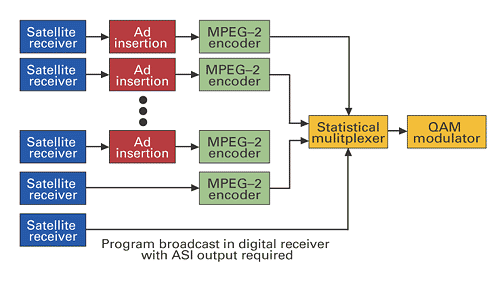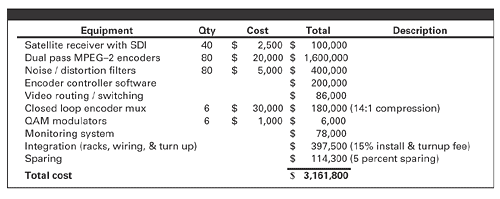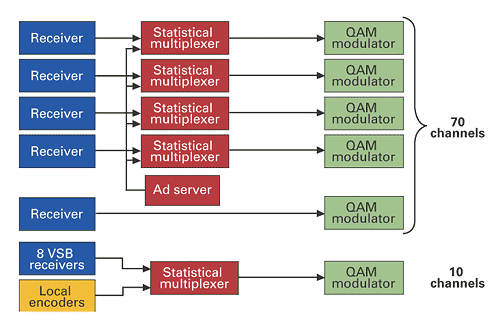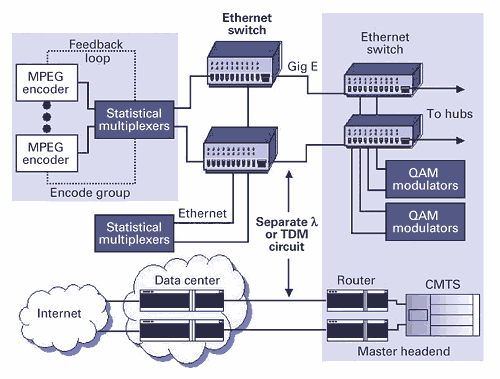All Digital: Coming to a Theatre Near You
There are several challenges to moving forward with an all-digital strategy. They include existing programming contracts, digital ad insertion and the cost/complexity of encoding the analog channels at each headend versus the distribution of the content from a centralized encoding and processing facility. Programming contracts Existing programming contracts are among the primary challenges to the all-digital migration. Programming contracts often tie analog carriage of less popular networks with discounted license fees to their more popular programming. So while it may sound easy to migrate the least popular expanded basic networks to the digital tier, this may have significant impact on the license fees paid for those affiliated networks left in the analog. Operators must review carefully their programming contracts and calculate the impact of a slow digital migration on their overall programming costs. They also need to consider the licensing fees in new contracts in relation to their digital strategy. The model that determines when digital will replace completely the analog tier must include the impact of programming costs. Because the programmers’ concern is maintaining the same customer footprint and not being disadvantaged by having only digital carriage when their competitors are in analog, taking every service to digital could help to control any additional programming license fees. Digital ad insertion Cable operators also make significant revenue from local ads. While dual carriage of the analog networks in a digital format can provide digital customers with better picture and sound quality, the loss of 35 percent of the analog audience capable of viewing local ads will impact this revenue stream severely. The local digital encoders could be placed after the analog ad insertion equipment, but this can triple the number of encoders required in headends with numerous commercial insertion zones. Digital ad insertion is the potential solution but increases the complexity and cost of the encoding process. Placement of the digital program insertion (DPI) tags, in accordance with the DVS 253 specification, is critical to enabling the commercials to be spliced during an I-frame where the transition would appear seamless to the viewer. There is also a question of scalability for the statistical multiplexers that must splice the commercials into the digital stream. Today the commercials are encoded at a data rate of between 5 Mbps and 6 Mbps. Program content, however, typically is encoded at a data rate of 3.75 Mbps or less if part of a statistical multiplexed pool. Because the commercial avails occur at nearly the same time on the different networks, there is an opportunity to exceed the throughput capacity of the digital channel. New equipment will be needed to encode the commercials to provide the same quality at a lower bit rate. The scalability of the statistical multiplexers also will need to be tested to identify how many channels that support local ad insertion can be placed in the same multiplex. Local encoding Low cost MPEG-2 encoders are coming available with a price tag in the $8,000 range. In a smaller headend with a single ad insertion zone these encoders could be placed after the commercial insertion equipment. (See Figure 1.) 
Figure 1: Local Encoding-After Commercial Insertion Equipment The headend cost to migrate an 80-channel analog system to digital using this approach is just over $500,000. (See Table 1.) Based on the cost estimates in Part 1 of this article (Communications Technology, April 2004), the savings of an all-digital migration when compared to a 750-MHz upgrade is over $1 million. After including the digital-headend cost of $515,000, the all-digital model still saves capital. 
Table 1: Local Encoding Costs The all-digital solution may meet the economic goals for an individual system, but a broader view is required. A cable operator must determine if local encoding at each headend scales across a number of systems. One question to ask is, does this approach achieve the goals of the all-digital migration? If providing picture and sound quality equal to satellite competitors is a primary digital driver, this approach may not meet that goal. Satellite providers consistently are rated high both for their picture and audio quality. They operate a single encode/uplink facility to serve their entire customer base and are able to use high-end dual pass MPEG-2 encoders with a variety of noise and distortion compensation filters. Even content encoded by a third party and received in a digital format is processed so that the picture quality and audio levels match. 
Table 2: Local Encoding Costs to Match Satellite Quality A simple model of the cost to encode every channel to match the satellite quality illustrates that the cost per headend quickly grows to beyond $3.1 million. (See Table 2.) The one benefit is that the encoding system is incorporated with the multiplexer through a feedback loop. This closed loop system enables a compression rate of up to 16:1 to deliver similar picture quality to a 12:1 open compression system using a traditional statistical multiplexer. Centralized encoding and distribution A centralized encoding center has advantages over installing numerous encoders in each headend. There are, however, costs associated with distributing content from a centralized facility. In a centralized model, digital commercial insertion is the only option. The DPI tags must be inserted at the encoding facility, and digital ad insertion equipment (splicers) must be installed at every headend. Centralization along with the use of high-end digital encoders simplifies the challenges of inserting DPI tags. As well, the cost of the DPI inserters can be leveraged across a number of headends. In the central environment, there also is not a requirement to encode the local channels. Only the 70 most popular cable programs need to be encoded and distributed. The equipment required at the local headend is reduced significantly. (See Figure 2.) Five receivers are needed to access the content that is encoded centrally. Four statistical multiplexers with DPI capabilities along with a digital ad server are needed for commercial insertion. Over-the-air receivers are needed to demodulate the broadcast networks so they can be multiplexed with locally encoded content. 
Figure 2: Local Headend Leveraging Centralized Encoding The cost for the equipment at the local headends can be as low as $250,000. (See Table 3.) This assumes a single commercial insertion zone and that the over-the-airs already are broadcast in digital and can be multiplexed with the local origination channels. 
Table 3: Headend Cost with Centralized Encoding Lower-cost option If the over-the-air channels are not available in a digital format they could be processed using a mid-range MPEG encoder. A second commercial insertion zone also could be added by installing another set of four statistical multiplexers and a second ad server. Even with these changes, the cost is still less-$477,000-than encoding every channel locally using low-cost encoders, and the quality is improved significantly. It is important to note that very small headends without local commercial insertion simply would need the receivers, QAM modulators and encoders necessary to digitize the local content. The headend cost for such a configuration could be less than $100,000. Centralized encoding has the opportunity to provide cable operators with a high-quality digital version of their analog channels with consistent audio levels between programs from various providers. The availability of this content would help to speed the industry’s migration to an all-digital product offering. The outstanding question for centralized encoding is the cost to distribute the content. Satellite transport The most obvious choice for delivering broadcast content from a central facility to remote sites is satellite distribution. In the scenario outlined, 14:1 compression into a 256-QAM channel was used during the encode process. Distributing 70 programs to a national footprint requires five 40 Mbps satellite transponders. The yearly operating cost for satellite distribution is roughly $8 million, assuming an annual lease per transponder of $1.5 million and $100,000 for the uplink. The benefit of this solution is that every headend in the United States can access the content for the $8 million. The one concern is the high cost for the actual data rate and bandwidth being used. The total capacity of these five transponders is a unidirectional 200 Mbps with a monthly cost of over $3,300 per megabit. This high cost for transport drives satellite providers to compress as many programs per transponder as possible. There is a very fine balance between the data rate allocated per program and the customer’s perception of quality. Today, 14:1 compression using a closed loop statmux is the benchmark. While data rate and bandwidth constraints are a similar concern for the cable industry in a dual-carry or stepped digital migration, in a true all-digital environment the 62 channels available in a 450-MHz system provide enough capacity to reduce the level of compression. Using 10:1 compression, 30 channels could deliver 300 standard definition programs at a quality that exceeds satellite, leaving 32 open channels for high definition television (HDTV), video-on-demand (VOD), data and voice services. If an operator selects satellite distribution from a centralized encode facility to its headends, 10:1 compression would require two additional transponders at a yearly operating cost of $3.2 million. The high cost of this distribution places cable operators in the same situation as their competitors, asking the question, “Is 14:1 compression good enough?” Terrestrial transport When contemplating video distribution from a central location to headends, the cable industry ought to look at terrestrial capabilities that already exist. Today’s architecture would mirror the VOD distribution network that has evolved on cable’s regional fiber networks. (See Figure 3.) A separate GigE wavelength would be used to distribute the video. In the case of an OC-48 backbone, a separate multiplex of STS channels within the circuit would be dedicated to support the video over Ethernet. 
Figure 3: Ethernet Video Distribution In Figure 3, the encode group is made up of the number of programs that the operator plans to multiplex into a 256-QAM channel. The output of the closed loop statistical multiplexer is an Ethernet feed to a nonblocking Ethernet switch. The switch aggregates all of the encode groups and marks them each with a virtual local area network (VLAN) tag. The Ethernet switch at the master headend switches each VLAN tag to the associated QAM modulator. The QAM modulator removes the Ethernet headers and modulates the MPEG video payload into a 6-MHz channel. The use of VLANs eliminates the need for statistical multiplexers at each headend. If, however, the operator wanted to create a unique program multiplex at the headend, a statistical multiplexer could be used. Another benefit is that the GigE transport feed could pass through to any primary hubs connected to the master headend, eliminating the need for racks of uncompressed digital video transport equipment. The cost for transport over a nationwide terrestrial fiber network constructed with leased OC-48 wavelengths is in the $50 per megabit range. A cable operator that elected to create encode groups using 10:1 compression to surpass satellite’s video quality would experience an 80 Mbps increase. On a terrestrial nationwide network this would cost the operator $48,000 per year versus the $3.2 million to lease two additional satellite transponders. Overcoming jitter One of the challenges of terrestrial distribution is managing network jitter and delay. The buffer capacity in the GigE edge QAM modulators deployed for VOD today can support 50 milliseconds of delay. If the Ethernet packets arrive out of sequence or at time intervals that exceed the buffer capacity, the picture on the customers TV will tile and freeze. The buffer capacity could be expanded to reduce the requirements on the transport network, but the additional delay will impact the customer experience in an interactive environment such as switched digital video. Response time was why a 50-millisecond threshold was selected for VOD in the first place. The other challenge to terrestrial distribution of video content is network reach. While the cost per megabit to access the high-speed backbone is low, the cost to lease bandwidth from remote locations back to tier 1 cities where the network can be accessed is prohibitive. The challenge is to find a way to increase the number of access points without adding a significant amount of cost, jitter or latency to the network. To understand if this is possible it is necessary to explore the architecture of a long-haul fiber network. In a traditional synchronous optical network (SONET) long-haul transport network, fiber amplifiers are located every 40 to 50 miles and the signal is regenerated every 250 miles. The problem is that although there are numerous facilities, access to the optical signals is not readily available at these locations, and the cost to install the SONET cross-connects is prohibitive. The cable industry has avoided this problem on its regional fiber networks. Dedicated GigE links used to distribute VOD streams from a centralized server are able to ride the same fiber as the SONET signals, but are not part of the SONET multiplex. They are a completely separate wavelength that can be dropped and passed at various locations by installing low-cost optical couplers and DWDM filters. VOD is an extremely asymmetrical service that closely resembles broadcast. A return wavelength is not required for the forward link. It is also possible for a single GigE transponder to serve multiple hub sites. The use of optical couplers and either DWDM de-multiplexers or a single channel ITU grid filter provides each hub site with access to the VOD content. This creates a very efficient design when compared to the cost of dedicating a transmitter and receiver to provide three separate point-to-point links. Applying this concept nationally is difficult if you attempt to overlay it on a SONET network. Some interesting opportunities arise if next generation switched optical networks are explored. Switched optical nets If the long-haul backbone is looked at simply as a physical layer transport system using DWDM to access the network, then many of the principles used in regional distribution can be applied. A wavelength can be configured to support unidirectional broadcast services. The remaining challenge is the distance a signal can travel before it must be regenerated. Each time the digital signal must be received, converted to electrical, and then converted back to the optical domain adds cost. Advances in optical amplifiers, transmitter linearity, receiver sensitivity and fiber performance have combined to solve this problem. In a switched optical network, a single transmitter placed at any of the optical network gateways or optical add/drop multiplexers can broadcast a wavelength across the entire optical backbone without the need for regeneration. The fact that the signal does not need to be regenerated and does not pass through a cascade of switches or routers, limits the network’s impact on the signals transmitted. This makes it an extremely efficient architecture for delivering services such as video that require tight SLAs for packet loss, jitter and latency. Even in a next-generation switched optical network, the add/drop multiplexers and network gateways are found only in tier 1 cities. While the network may deliver broadcast video efficiently to the NFL cities, it does not solve the coverage problem when compared to satellite. A closer look at the architecture reveals that while the signal does not need to be regenerated, amplifier huts still are required every 40 to 50 miles. Because this is a broadcast wavelength that is passing through these huts, two questions must be asked. Is it technically possible to access the wavelength transporting the broadcast signals across the backbone without affecting the other services on the core? If the answer is yes, what is the cost to access this wavelength at the hut locations? The latest version of most optical amplifiers includes a directional coupler port that provides access to all of the wavelengths on the backbone. It appears that access could be made available at a relatively low cost by adding a single-channel filter to select the broadcast wavelength and a digital receiver. If this turns out to be the case, fiber could become a very efficient means to distribute broadcast content. Terrestrial transport Terrestrial distribution could enable the cable operators to maintain programming exclusivity for their most valuable content. If programming is distributed over satellite, it must be made available to the competition. Cable exclusive programming that is available currently on regional fiber networks could be made available nationally. New cable-only networks also could be developed. A major challenge currently facing the cable industry is the escalating cost of programming. When there are relatively few content sources, those with the most popular content are able to exert a significant amount of leverage. A national fiber distribution network in conjunction with a switched digital network using QAM service groups from the headend to the home would allow cable operators to offer thousands of channels. A single 10 GigE wavelength can distribute 2,400 standard definition or 750 high-definition programs. A switched architecture at the headend would make these programs available to any customer on a multicast basis. Finally, the architecture suggested would provide cable operators with a service offering equal in program quality and quantity to anything the regional Bell operating companies (RBOCs) are contemplating with their fiber-to-the-home architectures. The cable industry can provide this service over its existing networks with minor modifications. The RBOCs and over-builders will need to spend several years building out their networks and will spend hundreds of billions of dollars in the process. The conclusion is simple: all-digital is coming. There is no one, right strategy to get to an all-digital product offering. The choice of local encoding, satellite distribution or terrestrial distribution will depend on the number, size and geographic location of the headends. Other things to consider are existing assets such as transponder capacity or high-speed connectivity between headends. The final consideration ought to be the company’s goals for new service offerings and strategies to beat the competition. The goal of the industry ought not to be simply to get to a bundled product offering, but to have the most efficient network to deliver a package of services that can stand alone against the competition. The migration to an all-digital product offering is an opportunity to take a fresh look at the networks that were built based on the requirements and technologies of the time, and to maximize their efficiency based on the requirements and technologies of today. Please see the April 2004 issue of Communications Technology for Part 1 of this article. Don Loheide is vice president of network engineering for Cequel III. Email him at don.loheide@cequel3.com. Nimrod Ben-Natan is director of narrowcast services convergent systems at Harmonic Inc. Email him at nimrod.ben-natan@harmonicinc.com. Bottom Line
All-Digital: Get Ready to Migrate All digital is coming. Whether a cable operator pursues a slow migration, dual carriage or does it tomorrow is highly dependent on the status of the market. There is no one, right strategy to get to an all-digital product offering. The choice of local encoding, satellite distribution or terrestrial distribution will depend on the number, size and geographic location of the headends. Other things to consider are existing assets such as transponder capacity or high-speed connectivity between headends. The final consideration ought to be the company’s goals for new service offerings and strategies to beat the competition.